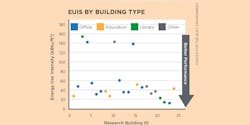Best Practices for Radiant Heating and Cooling
Radiant heating and cooling, an energy-efficient technology popular for net zero energy buildings, is starting to gain acceptance for a wider population of commercial facilities. Two recent studies by the Center for the Built Environment at the University of California, Berkeley, take a closer look at the effectiveness of radiant heating and cooling.
Performance and Perception
The first report focused on gathering energy performance data from buildings using any of three types of radiant heating and cooling: thermally activated building systems (TABS, where the radiant piping is embedded in the building structure), embedded surface systems (ESS, where the radiant piping is in a surface layer rather than in the structure itself), and radiant ceiling panels (the piping is in metal panels that are suspended from the ceiling). Covering 23 buildings, the research project was conducted with the help of the New Buildings Institute and included a wide variety of building types, sizes and climate zones.
The research team found several common threads among the studied buildings; for instance, a staggering percentage (74%) had obtained LEED Platinum certification and two had also been certified by the Living Building Challenge. All but one had some level of LEED certification. More than half (58%) used a ground source heat pump to satisfy primary heating needs, and chillers with cooling towers were the most common cooling source at 30%.
Most of the buildings also recorded an energy use intensity (EUI) rating significantly lower than similar buildings across the country as rated by national datasets, and two-thirds also had ENERGY STAR scores over 90, indicating that their energy performance puts them in the top 10th percentile of U.S. buildings of a similar type and climate. However, the researchers caution that this energy performance is not solely due to the radiant heating and cooling.
“It is clear that they are generally very high-performing buildings and the radiant system is a part of what is normally the largest contributor to energy use – the HVAC system,” the research team writes. “Obtaining low-energy outcomes can only be accomplished by addressing the HVAC as a system and involves an integrated design approach.”
This integrated approach involves energy-conscious design decisions that accommodate the chosen HVAC system, the researchers continue: “In the case of selecting a radiant system, it usually means limiting the overall design cooling load because there are physical limitations to how much cooling a radiant system can achieve.”
Design and Control Tips
The second study enlisted 11 radiant cooling experts to weigh in on ideal system configuration, controls, sequence of operation and commissioning for TABS cooling. Radiant cooling is less common than heating, so the interviewers aimed to increase the industry’s knowledge of best practices for these systems.
A review of the best practices shared during the interviews revealed several common themes. These included:
Pay attention to the envelope. Because radiant systems have limited cooling capacity and high thermal inertia, high-performance envelopes are crucial to reduce internal heat gain, the study notes. However, radiant cooling can dissipate solar radiation striking its surface much more quickly than other types of heat gain, so it’s sometimes specified in spaces where the solar heat gain is particularly bothersome.
Be proactive with temperature control. With radiant systems, indoor conditions don’t respond quickly to changes in the supply water temperature or the flow rate, so don’t rely on the reactive control strategies you use for conventional VAV. Aim to control TABS by maintaining a relatively constant temperature around the clock and don’t scale back the conditioning when the building is unoccupied. Large radiant zones are popular – some of the interviewees even aim to control the entire floor plate as a single zone.
Consider supplemental cooling. Most of the designers interviewed included some form of supplemental cooling in their buildings, either in select zones or throughout the entire building. This is especially helpful for spaces where occupancy can vary widely during the day. DOAS is frequently used to provide fresh air in radiant buildings and also provides supplemental cooling via an adjusted volume flow or a change in the supply air temperature.
Watch for condensation. Very few of the interviewees had encountered condensation in practice, and those who had blamed it on unusual situations (usually during startup) or improper operation. The condensation issues were successfully resolved through additional operator training and revising control sequences. Appropriate setpoints for the floor and DOAS systems should prevent condensation from occurring in many cases.
